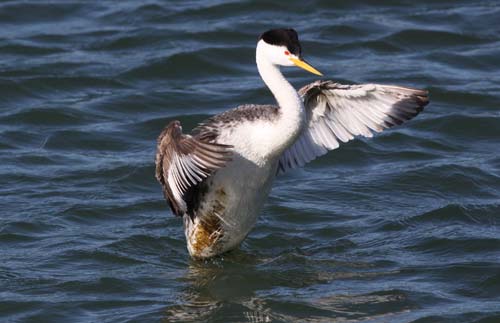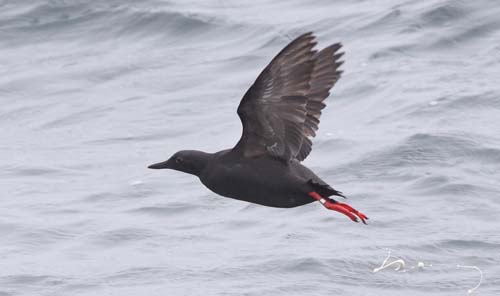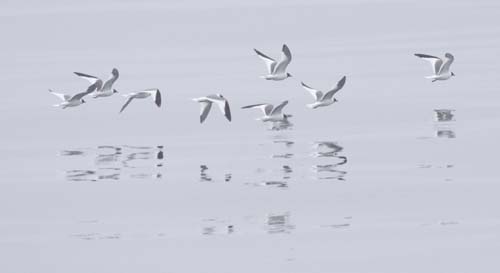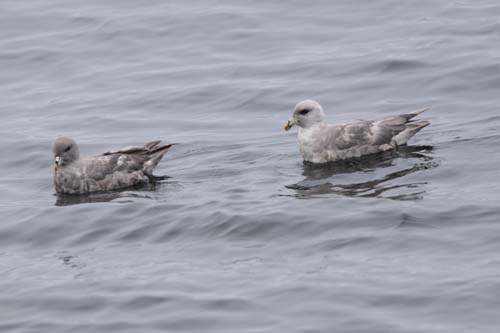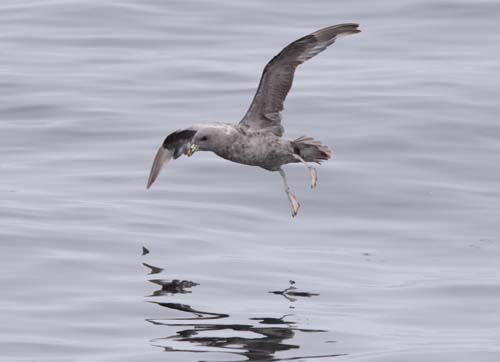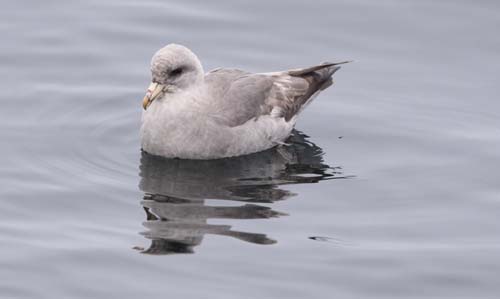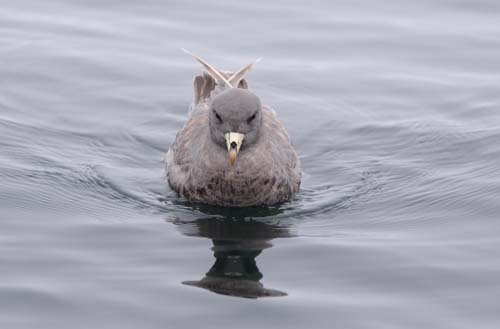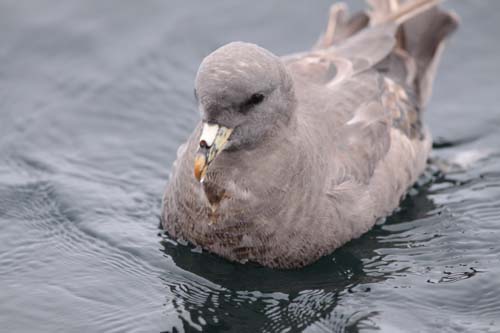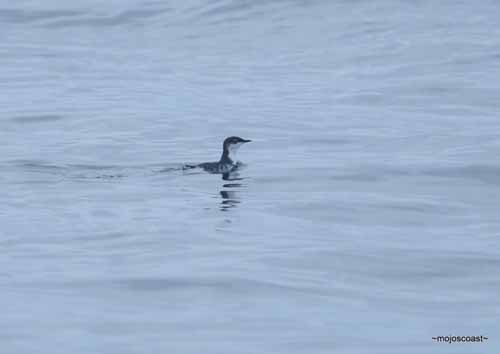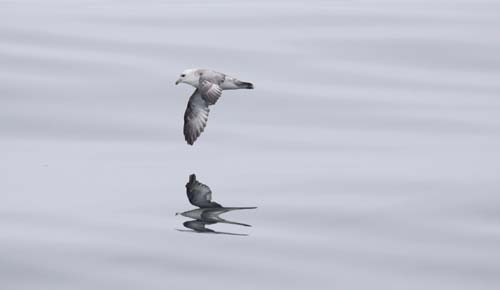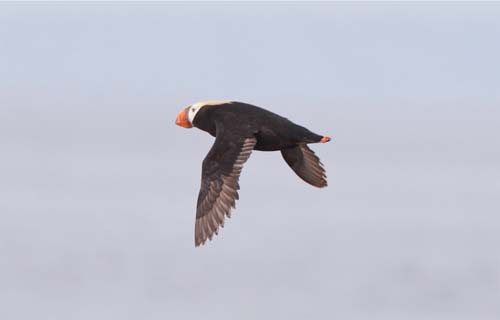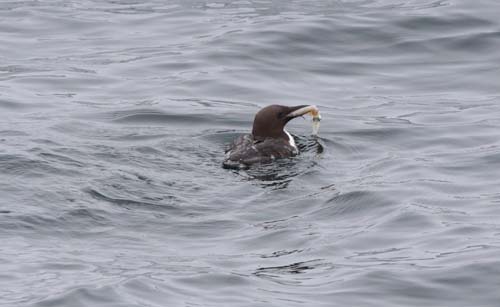Overview
The waters of Cordell Bank National Marine Sanctuary provide critical foraging habitat for many seabirds: 68 species have been identified feeding in the sanctuary. During the upwelling season, the highest levels of seabird biomass in central California waters are found at Cordell Bank, Monterey Bay and the Farallon ridge.
Oceanographic upwelling that originates from Point Arena provides conditions that are favorable for productivity of krill and small fishes, creating rich feeding grounds for seabirds here in the sanctuary. In addition, the proximity of very deep water close to the shallow feature of Cordell Bank creates unique local conditions for high productivity and optimal conditions for seabird foraging.
The composition of the seabird community within the sanctuary, like that of the fishes and marine mammals, is a mix of permanent and seasonal residents as well as species that use sanctuary waters for shorter time periods, either as a feeding destination or in transit during long-distance migratory journeys.
The majority of seabird species here are seasonal residents that breed in sites such as New Zealand, Chile and Alaska and then come here to feed during their non-breeding season. Among these is the Sooty Shearwater, which can number in the tens of thousands and is the most abundant seabird species off California.
Permanent resident bird species nest on the nearby Farallon Islands and in the Point Reyes area. For example, Cassin’s Auklets, which nest on the Farallon Islands, feed in Cordell Bank waters throughout the year and are one of the most numerous seabirds found in the sanctuary when krill is present (but can be virtually nonexistent here in the absence of krill).
In contrast, the Black-footed Albatross breeds thousands of miles from here yet still relies on the sanctuary’s rich food resources to feed its young. This amazing feat was documented in a recent study using satellite tags; it showed that albatrosses nesting on Tern Island and Midway Atoll in the northwestern Hawaiian Islands “commute” to Cordell Bank to gather food for their chicks. Other migratory species, including jaegers, phalaropes and Arctic Terns, use the productive waters around the bank as a stopover on their annual migration route.
Most of the species found in the waters surrounding Cordell Bank are “pelagic” birds, which only spend time on land to breed. Notable examples include Black-footed Albatross, Ashy Storm-Petrel, Sooty Shearwater and Pink-footed Shearwater during the summer and the fall, and Northern Fulmars during the winter and the spring. Other seabirds that frequent the sanctuary spend a large proportion of their time on land and in coastal areas, including several species of gulls, which are more common in the area of Cordell Bank in the winter.
Sanctuary waters are important to several bird species that are of special concern because of their small or declining populations. These population conditions may be a result of environmental change, habitat degradation, disease, human exploitation or a combination of these factors. Special-status species (based on listings by state, federal and/or international agencies and organizations) that are relatively abundant or common in the sanctuary include Black-footed Albatross, Ashy Storm Petrel, Pink-footed Shearwater, Cassin’s Auklet and Buller’s Shearwater.
Human impacts to seabird populations worldwide include competition for food with commercial and recreational fisheries, entanglement in fishing gear, ingestion of marine debris, and disturbance of roosting and breeding birds by watercraft and aircraft. Environmental contamination from the historical use of pesticides may still affect some species.
A number of small oil spills in the region have injured and killed many seabirds, including Common Murres and Rhinoceros Auklets, in neighboring central California sanctuaries. The possibility of a large oil spill from tankers transiting sanctuary waters is an ongoing threat to seabirds.
In addition to human impacts, changes in climate and oceanographic conditions also affect seabird populations. The prevalence of marine birds using sanctuary waters changes from year to year due to fluctuations in marine conditions, including El Niño Southern Oscillation, Pacific Decadal Oscillations, and changes in intensity and timing of upwelling conditions in the spring/summer. For example, the reproductive success of Cassin’s Auklets (a species that feeds heavily within sanctuary waters) on the Farallon Islands appears to be intricately dependent on the timing and intensity of oceanographic upwelling conditions, which influences food availability (especially krill) during critical life history stages.
Monitoring
Applied California Current Ecosystem Studies (ACCESS)
ACCESS is a research partnership to support integrated ocean management in northern and central California. Point Blue, Cordell Bank and Greater Farallones National Marine Sanctuaries have been investigating the spatial and temporal relationships between oceanographic processes, zooplankton, and marine birds and mammals the region encompassing Cordell Bank and Greater Farallones national marine sanctuaries. This project has several objectives, including: 1) Understand how the timing, intensity, and duration of upwelling influences the distribution and abundance of euphausiids (better known as krill) thus affecting the distribution and abundance of krill predators in the region; 2) Identify persistent locations of predator and prey aggregations and potential areas of high trophic transfer in the Greater Farallones region that may be associated with bathymetric and hydrographic features; 3) Monitor physical and biological characteristics of the pelagic ecosystem, with the goal of developing indicators of ecosystem health, to understand change on a variety of scales and detect natural and anthropogenic impacts.
Research cruises have been conducted in spring, summer and fall (three to five cruises per year) from 2004 to the present. This study has shown large inter-seasonal and inter-annual differences in lower trophic level abundance as well as predator presence in the sanctuaries. This assessment of the pelagic system specifically meets the sanctuary’s mandate to conduct long-term monitoring of the resources within the sanctuary and provides important information for resource protection and management.
Cordell Bank Ocean Monitoring Program
The Cordell Bank Ocean Monitoring Program (CBOMP) collected information on the spatial and temporal variability in the oceanographic system of the Cordell Bank region from 2004 to 2010. Data on the abundance of seabirds, marine mammals, other vertebrates and marine debris were collected by trained observers along six 12-kilometer east-west transects centered on Cordell Bank. Physical and biological characteristics of the pelagic system were measured along transects using a CTD (vertical profiles of salinity, temperature, chlorophyll-a, and light levels at set stations), TSG (continuous surface values of salinity, temperature, chlorophyll-a) and echo sounder (continuous measurements of relative abundance of zooplankton).
Starting in 2010, CBOMP was replaced by the Applied California Current Ecosystem Studies (ACCESS) program.
Tracking Black-Footed Albatross Movements and Conservation
The Black-footed Albatross, Phoebastria nigripes, has recently been listed as endangered by the World Conservation Union (IUCN). Assessing albatross movements and habitats during the post-breeding season is a top conservation priority.
Since 2004, the sanctuary has been supporting research by Oikonos Ecosystem Knowledge to study the post-breeding migration patterns and movements of Black-footed Albatross in the eastern Pacific Ocean. Twenty-eight birds were tagged in central California during the first three years of this study (2004-2005, 2007). Males and females were found to occupy different oceanic regions during the post-breeding season, with males venturing farther west than females. Data from 2004-2005 indicate that the tracked birds spent approximately 60 percent of their time in the high seas beyond national Exclusive Economic Zones. Of the time spend in U.S. territorial waters, 42 percent was spent within the three central California national marine sanctuaries.
CSCAPE: Collaborative Survey of Cetacean Abundance and the Pelagic Ecosystem
CSCAPE was a collaboration between the National Oceanic and Atmospheric Administration (NOAA) Fisheries and the National Marine Sanctuary Program to assess the abundance and distribution of marine mammals and characterize the pelagic ecosystem off the U.S. West Coast. Cruises were conducted every three years and covered the entire West Coast, from the northern boundary of Washington to the southern boundary of California, including concentrated sampling within the West Coast sanctuaries.
The project has three objectives:
- to conduct a marine mammal assessment survey within approximately 300 nautical miles of the shore, with additional fine-scale surveys within the sanctuary boundaries
- to characterize the pelagic ecosystem within the study area through the collection of underway and station-based biological and oceanographic data, seabird studies and acoustic sampling
- to conduct biopsy sampling and photo-identification studies of special-interest species
Tagging of Pacific Pelagics (TOPP)
A pilot program of the Census of Marine Life, the Tagging of Pacific Pelagics (TOPP) research project is part of an international endeavor to determine what lives in the world’s ocean. TOPP scientists explore the Pacific using satellite-tagged animals to gather data about their world. The results coming from these satellite-based research projects are expanding our understanding of marine wildlife and the role of the sanctuary in their feeding and migratory patterns. Seabirds that are tagged as part of the TOPP program include Pink-footed Shearwaters, Black-footed Albatrosses, Laysan Albatrosses and Sooty Shearwaters.
Photos
Maps
Projects
ACCESS - Applied California Current Ecosystem Studies
The Applied California Current Ecosystem Studies (ACCESS) is a partnership that supports marine wildlife conservation and healthy marine ecosystems in northern and central California by conducting ocean research to inform resource managers, policy makers and conservation partners.
California Cooperative Oceanic Fisheries Investigations (CalCOFI)
The California Cooperative Oceanic Fisheries Investigations (CalCOFI) was formed in 1949 to study the ecological aspects of the Pacific sardine population collapse off California. Today, the focus has shifted to the study of the marine environment off the coast of California, the management of its living resources, and monitoring the indicators of El Nino and climate change.
Cordell Bank Ocean Monitoring Program
The goal of the Cordell Bank Ocean Monitoring Program (CBOMP) is to characterize and monitor the spatial and temporal variability in the physical and biological components of the pelagic ecosystem in the region surrounding Cordell Bank. In addition, these data can be integrated with regional ocean observing programs to understand changes in the central California ocean environment. Monthly cruises (sometimes seasonally) were conducted from 2004-2010.CSCAPE: Collaborative Survey of Cetacean Abundance and the Pelagic Ecosystem.
CSCAPE is a collaboration between the National Marine Fisheries Service and the National Marine Sanctuary Program to assess the abundance and distribution of marine mammals and to characterize the pelagic ecosystem out to ~300 nautical miles off the U.S. West Coast.Modeling Black-footed Albatross Dispersion in Cordell Bank and Gulf of the Farallones National Marine Sanctuaries
Although Black-footed Albatross (Phoebastria nigripes; BFAL) breed mainly in the Northwester Hawaiian Islands, they are known to forage in California National Marine Sanctuaries. To understand the features relating to BFAL distribution in the sanctuary region, this research identifies the relative relationship of local, regional and basin-wide environmental characteristics with BFAL habitat use within Cordell Bank and Gulf of the Farallones National Marine Sanctuaries.Tagging of Pacific Predators (TOPP)
The Tagging of Pacific Pelagics (TOPP) research program aims to understand the migration patterns of large predators in the North Pacific basin and how these animals act and interact in their open ocean habitats. By using satellite tagging techniques, TOPP researchers follow the movements of different species across multiple trophic levels (i.e., the food web) and in relation to physical oceanographic features in order to piece together a whole ecosystem picture.Tracking Black-footed Albatross movements and conservation
Oikonos Ecosystem Knowledge, working with government and university partners has collected data on the oceanic distribution of post-breeding and chick provisioning Black-footed Albatross (Phoebastria nigripes) tagged at two locations (Cordell Bank and Kure Atoll) over four years (2004, 2005, 2007, 2008). Their distribution is described in the context of static oceanic habitats (bathymetric domains and features) and management jurisdictions.Links
A Year on the Wing
Information, activities and resources about birds and the ecology and culture of the places they visit. Includes free shorebird & flyway poster, education kits and much more. Choose documentary in flash or HTML format. Focused on the migratory wading birds of the East Asian-Australasian Flyway.http://www.abc.net.au/wing/ayowflash.htm
Birds of Elkhorn Slough
Resources for birdwatchers at Elkhorn Slough include a checklist, bird sightings log, and more information.http://www.elkhornslough.org/sloughlife/birds/
eBird
eBird, a project developed by the Cornell Lab of Ornithology and the National Audubon Society, provides a simple way for you to keep track of the birds you see anywhere in North America. You can retrieve information on your bird observations at any time for your personal use. You can also access the entire historical database to find out what other eBirders are reporting from across North America. In addition, the cumulative eBird database can be used to learn more about the distributions and movement patterns of birds across the continent.http://www.ebird.org/content/
eBird
eBird, a project developed by the Cornell Lab of Ornithology and the National Audubon Society, provides a simple way for you to keep track of the birds you see anywhere in North America. You can retrieve information on your bird observations at any time for your personal use. You can also access the entire historical database to find out what other eBirders are reporting from across North America. In addition, the cumulative eBird database can be used to learn more about the distributions and movement patterns of birds across the continent.http://www.ebird.org/content/
Elkhorn Slough National Estuarine Research Reserve – Caspian Tern Story
A case study of the trials and tribulations of Caspian Tern nesting colonies at Elkhorn Slough. Also check related information on their general website.http://www.elkhornslough.org/caspiantern/caspiantern.htm
International Brant Monitoring Project
The International Brant Monitoring Project was developed to monitor the migration of a small sea goose, the brant, along the Pacific Flyway. Participants gain a greater understanding of the importance of local ecosystems and global environmental health through the observation of brant and sharing of information. Students monitor through field observations and by counting brant in their area and then share their findings with others via the Internet.http://www.padillabay.gov/brant/
Monterey Bay Aquarium - Online Activity, "Bird Bingo"
The ocean and its coastline are home to hundreds of different types of birds, each with its own size, shape, and color. Bird bingo is a fun way for students to learn more about birds.http://www.mbayaq.org/lc/activities/bird_bingo.asp
Monterey Bay Aquarium - Student and Teacher Resources and Activities
The Monterey Bay Aquarium offers teacher and student resources including: species and habitat-specific information, live cams, classroom activities, and interactive online games.http://www.mbayaq.org/lc/
Monterey Bay National Marine Sanctuary - Seabirds and Shorebirds
A comprehensive and educational scientific characterization of birds in the Monterey Bay Sanctuary.http://montereybay.noaa.gov/sitechar/bird.html
Monterey Bay National Marine Sanctuary - Slideshow
Slideshow that includes photos of landscapes, marine mammals, birds and other organisms found in the Monterey Bay.http://montereybay.noaa.gov/visitor/slideshow/slideshow.html
Monterey Bay Pelagic Bird Images
See photos of pelagic birds taken in the Monterey Bay.http://www.montereybay.com/creagrus/MtyBaybirds.html
OBIS-SEAMAP: Ocean Biological Information System - Spatial Ecological Analysis of Megavertebrate Populations
A digital database of marine mammal, seabird, and sea turtle distribution and abundance. The web-based system will allow the interactive display, query, and analysis of the digital archive in conjunction with environmental data.http://seamap.env.duke.edu/
Pacific Seabird Group - Seabird Gallery
Images of Pacific Seabirds for use in public presentations and education.http://www.pacificseabirdgroup.org
PBRO: Point Reyes Bird Observatory - Conservation Science
PRBO Conservation Science's staff and seasonal scientists apply bird ecology studies to conserve birds, other wildlife and ecosystems in western North America, the north Pacific Ocean and beyond.http://www.prbo.org/cms/index.php
Point Reyes Bird Observatory - Conservation Education
Bird education resources, including: K-12 programs, bird and wildlife information, activities for kids, and information on birding in Pt. Reyes.http://www.prbo.org/cms/index.php?mid=40&module=browse
Satellie Tracking of the Sooty Shearwater
Maps of the Trans-Pacific migration of the Sooty Shearwater from satellite tracking. User must first accept the terms of use for the website.http://www.seaturtle.org/tracking/?project_id=46
Seabird Protection Network
Nearly 8 million people live in the San Francisco Bay Area. This fact, combined with the largest concentration of breeding seabirds in the contiguous U.S., give rise to many opportunities for wildlife disturbance. The Seabird Protection Network uses a 3-pronged approach: 1) Outreach & Education, 2) Enforcement & Coordinated Management, and 3) Monitoring, to informs coastal and ocean users about seabirds. The goal of the Network is to minimize human-related disturbances to breeding and roosting seabird colonies, along the central California coast. Open in new window:http://farallones.noaa.gov/eco/seabird/welcome.html
The Bridge - Ocean Sciences Teacher Resource Center
Materials and curricula related to many areas of study in the Monterey Bay. Be sure to check the data tip of the month archives. (Supported by the National Sea Grant Office, the National Oceanographic Partnership Program, and the National Marine Educators Association.)http://www.vims.edu/bridge/
U.S. Fish and Wildlife Service - Shorebird Sister Schools Program
Linking schools, biologists and shorebird enthusiasts along flyways, students from all over the western hemisphere track arctic-nesting shorebirds along their migration routes and share their class field experiences with other students. Students also have the opportunity to ask biologists questions, follow research projects and help scientists gather data. This site includes many on-line activities and curriculum for students and teachers.http://sssp.fws.gov/index.cfm
USGS - Surf Scoter Study
The San Francisco Bay Estuary Field Station of the U. S. Geological Survey, Western Ecological Research Center has been leading studies on the ecology of wintering waterbird populations and their contaminant risks, including cross-seasonal studies linking them to migration and breeding areas.http://www.werc.usgs.gov/project.aspx?projectid=179
